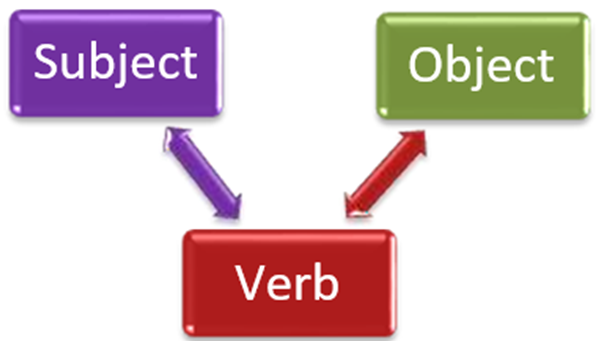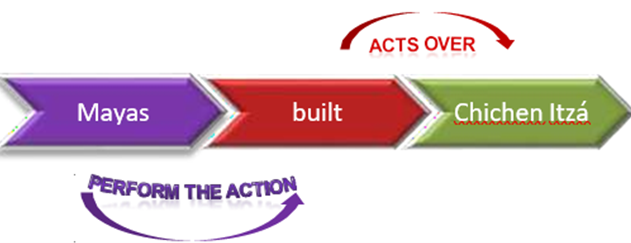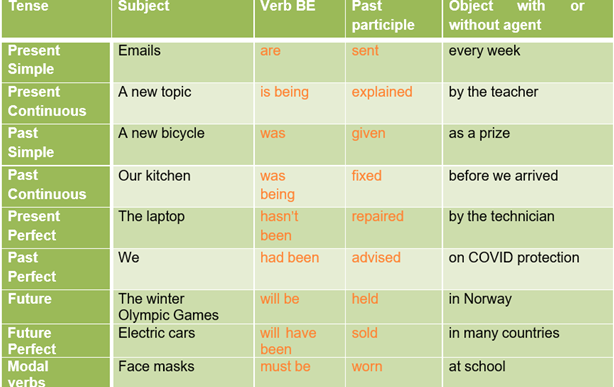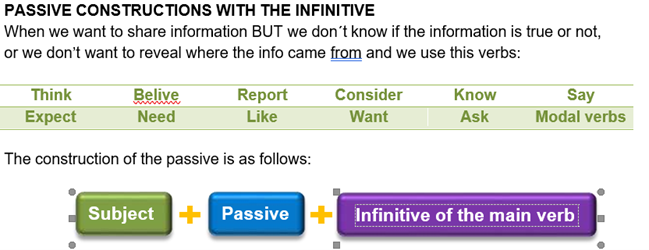I. WHAT IS PASSIVE VOICE?
The term voice describes the relationship between the verb, the subject and the object. The Passive Voice is when the subject receives the action of the verb, it is not a tense.

In Active voice the subject performs the action and the object receives the action and the object

For Example:

In the Passive Voice we emphasize other parts of the tense; we choose the passive voice to focus on the result instead of the person or the thing doing the action. The subject of the verb is the person or thing affected by the action. The order changes, so now the object becomes the subject and the subject is now called the AGENT

For Example:

II. FORM OF THE PASSIVE VOICE
As you could notice the tense of both sentences in the examples mentioned (Active and Passive) are in past, when we change Active to Passive or vice versa the tense doesn’t change.
When we use Passive Voice we need:
-
- the verb BE and this verb is the one that gives the tense to our sentence
- main verb in Past Participle For example:

III. INCLUDING THE AGENT (PERFORMER OR DOER).

We do not need to include the agent when:
- The agent is not important:
Trespassers will be prosecuted by the landowner
- We don´t know the agent. (somebody/a person):
My car has been stolen by somebody
- When the agent is obvious:
The cybercriminal was sentenced to 5 years imprisonment by the judge
- When the agent has already been mentioned:
Some of J.K. Rowling´s books have been written by her under the pseudonym Richard Bachman
IV. SENTENCES WITH TWO OBJECTS
To start this topic we need to remember Transitive and Intransitive Verbs, here is a small review to remind them:
- Some verbs called Transitive Verbs send the action to an object (an object could be a person or a thing), e.g.: I am reading “The Lord of the Rings: The Two Towers.
- Some verbs called Intransitive Verbs do not have an object but can be followed by an adverb or adjective, e.g.: I am reading a lot.
Any sentence might have two objects called Direct Object and Indirect Object. There are some verbs which can take two objects, some of these verbs are bring, get, give, make, offer, promise, send, show, etc. Here is an example:
The company gave many rewards to the best employees
- Direct object shows who or what the action of the verb affects, in other words it makes the question what or who does the verb, for example: “What did the company give?”
- Indirect object is the recipient of the direct object, an indirect object cannot exist without a direct object, to put it in another way they answer questions like to whom or for whom or for what, for instance: “To whom did they give awards?”
Direct object: many rewards
Indirect Object: to the best employees
The Passive form of this sentence now can be written in two different ways:
- Many rewards were given to the best employees (by the company)
- The best employees were given many rewards (by the company)
V. INFINITIVES

Francoise Bettencourt Meyers is thought to be the richest woman in the world.
The complete victim’s family is believed to have a new identity.
VI. CONSOLIDATION I.
VII. CONSOLIDATION II.
VIII. PRACTICE I.
IX. EXERCISE II.
X. READING TEXT.
READING COMPREHENSION AND VOCABULARY BUILDING
Children Create Posters for Peace

(NewsUSA) - When Yennie Shyu, a 12-year-old from San Jose, California, tried (1) ____ peace, she immediately thought of e-mail.
"In this age, technology and computers are very popular, so I thought about combining technology and e-mail with spreading the message of peace and love," said Shyu, whose poster, which (2) ____ little girls e-mailing olive branch- carrying doves, won the 21st Lions Clubs International Peace Poster Contest.
Shyu describes the image as "little fingers (3) ____ big messages, spreading love and peace worldwide."
Shyu's poster, which (4) ____ from 350,000 entries from 70 countries, portrays the theme "Peace Begins With Me." As the grand prize winner, Shyu
received a trip to New York City for a special award ceremony during Lions Day with the United Nations.

"Lions in many nations (5) ____ the Peace Poster Contest as a hands-on way to promote peace and to support the young people in their communities," said Lions Clubs International President Al Brandel. "The contest is another example of Lions being everyday heroes in reaching out and listening to the young people of this world."
During the past two decades, more than 4 million children from ages 11 through 13 have artistically shared their visions for peace through the Lions International Peace Poster Contest. Lions clubs (6) ____ the contest in schools and organized youth programs. The contest provides an outlet for children and adults to discuss the meaning of world peace while visually portraying their feelings. Now entering its 22nd year, the contest (7) ____ in more than 100 countries.
"It takes energy and even courage to live in peace," said Remi Delanghe, a merit award winner from Belgium. "It's something you need to work on every day in order to be able to create and (8) ____ it."
Winners have come from all across the globe to share their visions of peace. "Peace is something big and marvelous, full of happiness (9) ____ from our own homes and in the heart of each human being," said Ana Stephanie Rosero Morales from Peru, a merit award winner.
The 24 finalist peace posters (10) ____ during the year at children's museums and various locations throughout the United States. Visit www.lionsclubs.org to view posters and send e-cards.
XI. PRACTICE I.
XI PRACTICE II.
XII. BIBLIOGRAPHY
Eastwood, John. (2002). Oxford Guide to English Grammar. Oxford University Press.
Hewings, Martin. (2013) Advanced Grammar in Use with Answers. Second Edition. A Self-StudyReference and Practice Book for Advanced Learners of English. CambridgeUniversity Press.
Parrott, Martin. (2004). Grammar for English Language Teachers. Second Edition. Cambridge University Press.
XIII. WEB RESOURCES
- https://www.copyrightfreecontent.com/?s=children+create+posters
- https://freetts.com/#ads Audio version performed by Kendra_FREETTS: Text to Speech Converter
- Image 1 https://pixabay.com/es/photos/foto-art-ni%c3%b1os-jugando-pintando- 3853950/
- https://audio-joiner.com/es/
XIV. REFERENCES.
Table 1. Own source
XV. CREDITS.
- Practice exercises written by Cecilia Guadalupe Harumi Gavaldón Hoshiko_Language Department at UNAM-ENES-LEON
- Audio part 1_https://freetts.com/#ads Audio version performed by Salii_FREETTS: Text to Speech Converter
- Audio part 2_https://freetts.com/#ads Audio version performed by Joey_FREETTS: Text to Speech Converter
- Practice exercise written by Cecilia Guadalupe Harumi Gavaldón Hoshiko. Language Department at UNAM-ENES-LEON
- Practice exercise written by Cecilia Guadalupe Harumi Gavaldón Hoshiko. Language Department at UNAM-ENES-LEON
- Image 2. https://www.freepik.es/vector-gratis/fondo-plano-paz-paloma- ilustrada_14251340.htm. Free stock Photos.
-
<a href="https://www.freepik.es/vectores/palestina">Vector de palestina creado por freepik - www.freepik.es</a>